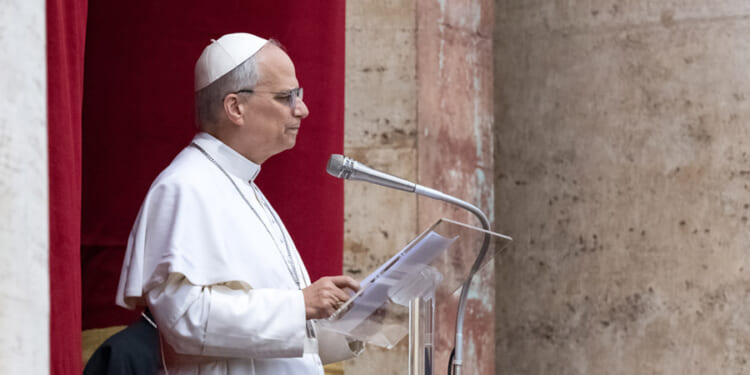“The English follow the principle that when one lies, one should lie big and stick to it. They keep up their lies, even at the risk of looking ridiculous,” Josef Goebbels, Hitler’s minister of propaganda, wrote in a 1941 essay titled Churchill’s Lie Factory.
Had the Machiavellian Goebbels adopted Cardinal Newman’s dictum of burrowing “deep into history,” he might have discovered that the Roman Catholic hierarchy would win hands down if pitted in a “Big Lie” contest against the English.
Rome’s Juicy Historical Fibs
Over the centuries, Rome conjured up whopping porkies to steamroll its global hegemony.
Fr. Johann Josef Ignaz von Döllinger, celebrated as “the most learned Church historian in Germany,” listed over seven forgeries used by the popes to turn the Petrine office into “an absolute monarchy subjected to the arbitrary power of a single individual.” Döllinger was writing just before Vatican I.
The fabrications include the pseudo-Isidorian decretals, the Liber Pontificalis, the Donation of Constantine, the Donations of Pepin and Charlemagne, and the Gratian Decretum. Döllinger, whom Newman greatly admired, argued that the fakes laid the fictitious edifice for papal infallibility. The German historian dismissed papal infallibility as “moonshine” based on “forgeries and fictions.”
Rome excommunicated Döllinger for exposing the bruta facta of history and for refusing to burn incense to the innovation of papal infallibility.
Breeding Dogmas
Many honest Catholic historians and theologians acknowledge that Rome’s hierarchy has engaged in pathological lying over the centuries, especially when peddling pious fiction as dogma.
“Putting it bluntly, the Catholic Church does the opposite of a used car dealer,” remarks Dr. Michael Seewald, professor of dogmatic theology at the University of Münster. While the used car dealer “wants to sell an old car by advertising it as much as possible as new, the Catholic Church constantly sells new cars but passes them off as old cars.”
Examples confirming Seewald’s analogy abound in the Council of Trent’s dogmatic statements, which insist that accretions like the cultic priesthood or the Mass as a propitiatory sacrifice were instituted by Jesus. But Jesus “designated none of his followers as priests,” the eminent Catholic biblical scholar Fr. Raymond Brown writes in his book Biblical Exegesis and Church Doctrine, debunking the rickety scaffolding of Tridentine sacerdotalism. And Fr. Robert J. Daly blows sky-high the idea of the Mass as a propitiatory sacrifice in his book Sacrifice Unveiled: The True Meaning of Christian Sacrifice, proving that sacrifice in the New Testament is “ethical, not cultic.”
We all know how Pope Francis lied about the safety and efficacy of the vaccine, masks, and lockdowns during the COVID-19 scamdemic. Francis and Leo both peddle scary fairy tales about climate change and soothing bedtime stories about the benefits of mass migration. Popes and bishops lie like a broken record with a crack like the Grand Canyon when protecting predator priests. And they lie about Islam being a “religion of peace.”
Leo’s Supercalifragilisticexpialidocious Lie
On October 10, Pope Leo XIV spouted a supercalifragilisticexpialidocious fib while addressing a delegation of Aid to the Church in Need International on the topic of religious freedom. The pontiff argued that “the right to religious freedom is not optional but essential” because it “allows individuals and communities to seek the truth, to live it freely, and to bear witness to it openly.”
The Grand Panjandrum of Catholicism then gloriously gaslighted his audience, bombastically bragging: “For this reason, the Catholic Church has always defended religious freedom for all people.” What a leviathan of a lie!
Leo wasn’t making this grandiloquent claim as Bob, the village oaf. Leo is the global CEO of 1.8 billion Catholics. He’s got a doctorate. He was a diocesan bishop, superior general of the Augustinian Order, and prefect of the Dicastery for Bishops. And yet he asserts that the Roman Church has always defended religious freedom?
Leo’s crock is particularly egregious given the long and brutal history of Rome’s persecution against religious dissidents — Jews, Lollards, Hussites, Waldensians, Albigensians (Cathars), Protestants, Huguenots, Anabaptists, etc. Sure, there were times when Protestants returned the favour and persecuted Catholics — a good example is Queen Elizabeth I. But it would be fair to say that until the promulgation of Dignitatis Humanae, the Second Vatican Council’s decree on religious freedom, Rome was almost always an enemy of religious freedom rather than its friend.
Traditionalist Catholics Know Leo is Lying
Leo’s claim that the Catholic Church has always defended religious freedom for all people is the irony of ironies for traditionalist Catholics. On the one hand, the trads are the fiercest opponents of Dignitatis Humanae. They take their cue from Archbishop Marcel Lefebvre, who refused to sign the Declaration on Religious Liberty. On the other hand, it is the trads who are now whingeing the loudest because Francis and Leo have taken away their religious freedom by severely restricting the Traditional Latin Mass.
Another delectable irony is how Rome, which now suffocates the Tridentine Mass, is the same despotic dictatorship that persecuted the ancient Thomas Christians of India for offering the Holy Qurbana according to the East and West Syriac rites (which predate the Traditional Latin Mass) and not according to the Tridentine rite.
I know this only too well from my Christian students who trace their lineage to the church established by St. Thomas in India in 52AD. Chaldean prelates sent to India to minister to the Thomas Christians were captured, expelled, imprisoned, or executed under the Padroado — an arrangement between the pope and the Portuguese government under which the Vatican delegated to the government the right to administer churches across the world.
Long surrounded by Hindu idolatry, the Thomas Christians abhorred icons, idols, or images of any sort, whether of the Virgin Mary, the Apostles, or patron saints, and steadfastly refused to venerate images, writes Prof Eric Frykenberg, in his book Christianity in India: From Beginnings to the Present. So Rome persecuted them even more.
What God Permits, Rome Prohibits
Rome’s actions in constricting religious freedom are even more reprehensible in those cases where the Catholic hierarchy persecuted Christians for merely obeying what God had commanded in Scripture. The Thomas Christians were complying with the second commandment in the Decalogue, which prohibits the fashioning of graven images.
One reason why the Council of Constance had the Catholic priest Jan Hus burned at the stake was because Hus wanted the laity to be given communion in both species of bread and wine, in obedience to Jesus’ command. On October 30, 1962, during a general session of Vatican II, Cardinal Bernardus Alfrink affirmed Hus, stating: “In refusing to give the chalice to the laity, the Church was depriving them of their right to conform to Christ’s injunction.”
Other cardinals, including Frings, Doepfner, and Leger, agreed. “Hus’ fidelity to scripture is unimpeachable,” writes Catholic historian Thomas Fudge in his magisterial book Jan Hus: Religious Reform and Social Revolution in Bohemia.
Similarly, the Church’s hierarchy ordered the execution of the Catholic priest William Tyndale for his translation of the Bible into English, falsely claiming that Tyndale’s translation was heretical, chiefly because he translated the Greek words ekklēsia as “congregation” instead of “church,” presbyteros as “elder” instead of “priest,” agape as “love” instead of “charity,” and metanoia as “repentance” instead of “[do] penance.”
Tyndale’s translation of these four words was correct both philologically and theologically, as modern Catholic biblical scholars agree. However, to render the original Greek accurately, particularly in the case of ekklesia, presbyteros, and metanoia, was to plant a nuclear bomb in the heart of medieval Catholicism’s sacerdotal edifice.
No Religious Freedom For Biblical Scholars
Is Leo so completely illiterate as a canonist that he hasn’t heard of Quanta Cura — Pope Pius IX’s encyclical, which so categorically condemned religious freedom? Citing Pope Gregory XVI’s encyclical Mirari Vos, Pius excoriated the very idea of religious freedom as “delirium.”
Or isn’t Leo aware of the Index Librorum Prohibitorum (the catalogue of forbidden books) which listed the works of numerous theologians, as well as philosophers and scientists like Copernicus, Galileo, Descartes, Pascal, Bayle, Kant, Hobbes, Locke, Hume, J.S. Mill, as well as the great historians like Gibbon, Concordet, Ranke, Taine, and Gregorovius?
It is ironic that even though the seventeenth-century Catholic priest and scholar Fr. Richard Simon is accorded the honour of being “father of biblical criticism,” it is only since the publication of Divino Afflante Spiritu by Pope Pius XII in 1943 that Catholic biblical scholars have been afforded the pleasure of using historical tools of investigation without fearing the wrath of Rome coming down like a guillotine on their necks.
And is Bob blissfully unaware of his namesake, Leo X? In 1520, Leo X published the bull Exsurge Domine, declaring that it was the will of the Holy Spirit to burn heretics. Leo, following Francis, now declares the death penalty to be inadmissible, but surely he can admit to Leo X’s absolute intolerance of religious freedom?
Leo Contradicts Himself
Perhaps the most charitable conclusion one can arrive at is that Leo suffers from papal amnesia. He says one thing today, and he forgets what he has said, so he says the opposite tomorrow.
On May 29, Leo sent a message to Anabaptists who were marking the 500 years of their movement in Zurich. His statement was diplomatically worded, but he acknowledged a need for “honesty and kindness in reflecting on our common history, which includes painful wounds and narratives that affect Catholic-Mennonite relationships and perceptions up to the present day.”
Now, why would he do that? In 1571, Catholic authorities in Amsterdam convicted Anneken Heyndricks of being baptized as an adult, refusing to go to confession, belonging to a group of Anabaptists, and marrying an Anabaptist. Heyndricks was extensively tortured. Her mouth was filled with gunpowder, and she was burned to death.
Heyndricks is one of the thousands of martyrs from the 16th-century Anabaptist movement, best known today for its commitment to pacifism.
While Anabaptists were uniquely persecuted by both Catholics and Protestants (Lutherans and Calvinists), 85% of their executions “were carried out by Catholic authorities, particularly the Austrian Habsburgs, the dukes of Bavaria and the Swabian League,” writes James M. Stayer in the Brill Companion to Anabaptism and Spiritualism, 1521-1700.
Leo’s Terminological Inexactitude
How can one forget the Jews? Leo was living in Rome when the movie Rapito (Kidnapped) was released in 2024. The film brings to life the horrors of the papal police kidnapping of Jewish children who’d been clandestinely baptized by their Catholic maids, who thought they were dying. From 1814 to 1818, papal gendarmerie raided the Jewish ghetto in Rome 22 times (always at night). They kidnapped 17 married women, three fiancées, and 27 children.
Has Leo forgotten how his predecessors over the centuries (with notable exceptions) locked the Jews in ghettos, forced them to wear distinct clothing, persecuted them in the Inquisitions, and expelled them from one Catholic country after the other?
Historian David Kertzer writes in his book The Popes Against the Jews: “For the popes, modernity meant all the things that Church doctrine rejected: freedom of religion, of speech, of the press; the notion of separation between Church and state. In his struggle, Jews came to occupy a surprisingly important place.”
Kertzer explains how the emancipation of Jews in one country after another, “in the face of the strong opposition of the popes,” and the “admission of Jews to equal civil footing with Christians went directly counter to Church doctrine.”
In Britain’s House of Commons, a Member of Parliament isn’t allowed to call a fellow parliamentarian a “liar.” Not surprisingly, politicians have invented a host of circumlocutions evolved to bypass this time-honoured convention. Winston Churchill is credited with coining the exquisite euphemism for a “lie,” i.e., a “terminological inexactitude.”
Popesplainers take note: Leo isn’t lying about the Catholic Church always defending religious freedom for all people. He is guilty of merely parroting a supercalifragilisticexpialidocious terminological inexactitude.
Canon Dr. Jules Gomes (BA, BD, MTh, PhD) has a doctorate in biblical studies from the University of Cambridge. Currently a Vatican-accredited journalist based in Rome, he is the author of five books and several academic articles. Gomes lectured at Catholic and Protestant seminaries and universities and was canon theologian and artistic director at Liverpool Cathedral.




![Hegseth Demands Fitness Requirements, Says 'Fat Troops' 'Not Who We Are' [WATCH]](https://teamredvictory.com/wp-content/uploads/2025/09/Hegseth-Demands-Fitness-Requirements-Says-Fat-Troops-Not-Who-We-350x250.jpg)






